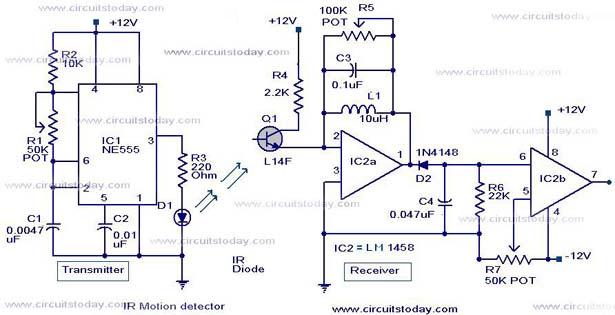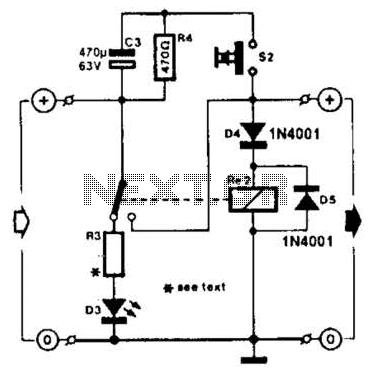
Remote Controlled Alarm circuit

A remote-controlled alarm circuit utilizing the TSOP1736 is designed for easy use by elderly individuals or patients confined to bed. This battery-operated alarm system eliminates the need for routing electric cables to a calling bell switch, making it a practical solution for home or hospital environments. The circuit can be activated with any infrared remote control handset operating at 36 kHz. Central to the design is the TSOP1736 integrated infrared sensor, which is a compact receiver specifically tailored for infrared remote control applications. The sensor comprises a PIN diode and a preamplifier integrated into a lead frame, with an epoxy package that acts as an infrared filter. To enhance performance, the circuit includes a bandpass filter, an integrator stage, and automatic gain control, which collectively minimize unwanted noise interference. When assistance is required, the user simply needs to press and hold any button on the remote control while aiming it at the sensor (IRRX) of the alarm circuit. This action prompts the piezo buzzer to emit a beeping sound synchronized with the modulated infrared signals from the remote. Additionally, a visual alert is provided by a red 10mm LED (D2). After assembly, the entire remote-controlled alarm unit should be housed in a transparent enclosure, with the infrared sensor positioned at the front. The circuit is powered by a 9V alkaline battery, and incorporating an on/off toggle switch in the positive rail is advisable. Once testing is completed, the unit can be mounted on a wall at an appropriate location. The prototype may be connected to a multidirectional 5V DC buzzer, although any standard 5V DC buzzer or active piezo sounder can be utilized.
The remote-controlled alarm circuit is designed to enhance the safety and comfort of elderly patients or individuals with limited mobility. The use of the TSOP1736 sensor allows for reliable operation with commonly available infrared remote controls, ensuring that the system is accessible and user-friendly. The integration of noise suppression components, such as the bandpass filter and automatic gain control, ensures that the alarm operates effectively in various environments, reducing the likelihood of false alarms caused by ambient infrared interference.
The active piezo buzzer serves as the primary alert mechanism, providing an audible signal that can be easily heard by caregivers or family members. The inclusion of the visual alert in the form of a red LED adds an additional layer of notification, making it easier for individuals to identify when the alarm has been activated, especially in noisy or busy environments.
When constructing the circuit, careful attention should be paid to the placement of the infrared sensor, as it must have a clear line of sight to the remote control for optimal performance. The transparent enclosure not only protects the components but also allows for easy visibility of the LED indicator. The use of a 9V alkaline battery ensures that the system remains portable and can be easily relocated as needed.
Overall, this remote-controlled alarm circuit represents a practical solution for enhancing communication and safety for patients and elderly individuals, facilitating prompt assistance when needed.A very interesting remote controlled alarm circuit using TSOP1736. Routing of an electric cable to attach a calling bell switch near the bed of an old age/patient is not a good idea. Here is an ultra simple battery operated remote controlled alarm to help old age members/patients in bed, especially at home/hospital.
Any tv/video infrared remote co ntrol handset (36Khz) can be used to arm the alarm! At the heart of the circuit is the popular integrated infrared sensor TSOP1736. The TSOP1736 is a miniaturized receiver for infrared remote control systems. PIN diode and preamplifier are assembled on lead frame, the epoxy package is designed as an infrared filter. Further, a bandpassfilter, an integrator stage and an automatic gain control are used to suppress unwanted noise disturbances.
When a person needs immediate attention of someone, he should firmly press and hold any button in the keyapad of the remote control handset and aim the handset towards the sensor (IRRX) of the alarm circuit. Instantly, the active piezo-buzzer stars beeping in tune with the modulated infrared signals emitted by the handset.
Sametime, a good visual alert is provided by the red colored 10mm LED(D2). After construction, enclose the whole remote controlled siren unit in a transparent cabinet with the Infrared sensor at the front side of the box. Now power the circuit through a suitable 9V compact alkaline battery. Insertion of an ordinary on/off toggle switch in the positive rail is a good idea. After successful testing, mount the unit in a proper point at the wall of the room/hall, as per the requirement.
Finally, the lab prototype is connected to a multidirectional 5V dc buzzer. However, you can use an ordinary 5V dc buzzer or any kind of 5V active piezo-sounder. 🔗 External reference
The remote-controlled alarm circuit is designed to enhance the safety and comfort of elderly patients or individuals with limited mobility. The use of the TSOP1736 sensor allows for reliable operation with commonly available infrared remote controls, ensuring that the system is accessible and user-friendly. The integration of noise suppression components, such as the bandpass filter and automatic gain control, ensures that the alarm operates effectively in various environments, reducing the likelihood of false alarms caused by ambient infrared interference.
The active piezo buzzer serves as the primary alert mechanism, providing an audible signal that can be easily heard by caregivers or family members. The inclusion of the visual alert in the form of a red LED adds an additional layer of notification, making it easier for individuals to identify when the alarm has been activated, especially in noisy or busy environments.
When constructing the circuit, careful attention should be paid to the placement of the infrared sensor, as it must have a clear line of sight to the remote control for optimal performance. The transparent enclosure not only protects the components but also allows for easy visibility of the LED indicator. The use of a 9V alkaline battery ensures that the system remains portable and can be easily relocated as needed.
Overall, this remote-controlled alarm circuit represents a practical solution for enhancing communication and safety for patients and elderly individuals, facilitating prompt assistance when needed.A very interesting remote controlled alarm circuit using TSOP1736. Routing of an electric cable to attach a calling bell switch near the bed of an old age/patient is not a good idea. Here is an ultra simple battery operated remote controlled alarm to help old age members/patients in bed, especially at home/hospital.
Any tv/video infrared remote co ntrol handset (36Khz) can be used to arm the alarm! At the heart of the circuit is the popular integrated infrared sensor TSOP1736. The TSOP1736 is a miniaturized receiver for infrared remote control systems. PIN diode and preamplifier are assembled on lead frame, the epoxy package is designed as an infrared filter. Further, a bandpassfilter, an integrator stage and an automatic gain control are used to suppress unwanted noise disturbances.
When a person needs immediate attention of someone, he should firmly press and hold any button in the keyapad of the remote control handset and aim the handset towards the sensor (IRRX) of the alarm circuit. Instantly, the active piezo-buzzer stars beeping in tune with the modulated infrared signals emitted by the handset.
Sametime, a good visual alert is provided by the red colored 10mm LED(D2). After construction, enclose the whole remote controlled siren unit in a transparent cabinet with the Infrared sensor at the front side of the box. Now power the circuit through a suitable 9V compact alkaline battery. Insertion of an ordinary on/off toggle switch in the positive rail is a good idea. After successful testing, mount the unit in a proper point at the wall of the room/hall, as per the requirement.
Finally, the lab prototype is connected to a multidirectional 5V dc buzzer. However, you can use an ordinary 5V dc buzzer or any kind of 5V active piezo-sounder. 🔗 External reference





